Wine Tasting: New Zealand & International Wines
- Celia Hay
Wine Room Tasting Notes by Jeremy Ellis, Committee member of the New Zealand Sommelier's & Wine Professionals Association
The New Zealand Sommelier and Wine Professional of the Year competition of 2019 showed an excellent arrangement of skills by the many contestants. Further to this we had several suppliers on site talking, displaying and showing their latest vintages, or special highlights they had hidden away for showing to professionals of the hospitality trade.
The range, represented was great and an excellent opportunity to have some one on one time with people to discuss their wines more directly. Normally such events also engage the general public, whom tend to take a more social focus to such tastings. Because of this we, in the hospitality trade, often don’t get the time to discuss wines in detail with the people whom make or represent these products to the market.
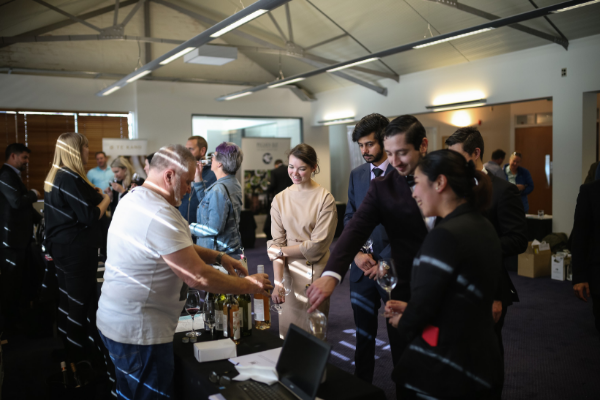
John Hancock pours for New Zealand Sommelier Award Competitors.
I started at one end of the room and made my way around, taking notes regarding the highlights I discovered. I didn’t get to everyone but did cover the room and below is my tasting notes for some of the wines displayed. I missed several stands because some of them I knew the wines well already. There were noticeably quality wines available from Villa Maria, Pernod Ricard, Te Kono, Hanz Herzog and several other wineries. I tried to make my way around but - simply put too many!
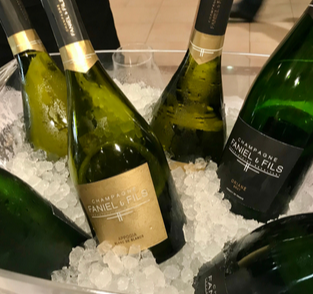
-8.png?201908192104)
Elephant Hill & Vidal Wines
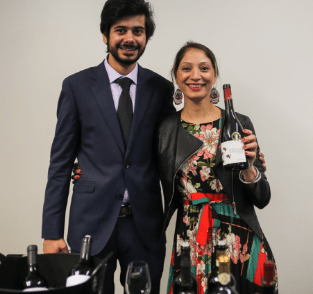
-7.png?201908192120)
Valentina and Sapori Wines.
Approaching the first stand, my attention was brought immediately to the Massifitti 2018 Soave (%100 Trebianno). The cool squat bottle immediately brings your attention as it stands out from the rest. The blacked glass and white label ooze some sophistication, but more importantly the focus of this producer single varietal expressions in a Soave wine, means it is immediately more serious. DOC and Classico status also mean its comes form the centralised vineyards with old vines. This area is dominated by alluvial soils close to Adige river, in Italy’s north east. As part of the Veneto region it was expanded enormously through the late 60’s to nearly 5,000+ hectares from the 1927 1500 hectares originally eliminated in 1927. Since then there have been huge debates and concerns about the quality of the wine known as Soave.
This combination of DOC, Classico and a focus on a single grape variety is far removed from the Soave of old. Prior to the early 90’s, Soave was a bulk produced wine. The Italian Government’s focus was on quantity over quality, and consequently its reputation was not good, beyond cheap dry white to go with fish. Trebbiano dominated over Garganega, Pinot Blanc and Chardonnay (the 4 legally allowed varieties), the wines tended to be dilute, with cropping for Trebianno de Soave as high as 60 tonnes per hectare. Chardonnay, Pinot Blanc and Garganega tended to be an after thought, and almost no-one used any wine making methods beyond primary fermentation and some filtering.
Thankfully in the late 80’s and early 90’s there was a strong movement by wine makers of north east Italy to produce quality over quantity, and while there were several years of back and forwards on this movement, eventually and thankfully the wine makers won.
The Suavia Monte Carbonare Soave was first produced in 1986 was an effort by Suavia to really focus on quality. They decided to focus on one grape- Garganega. The team at Suavia modified the standard of their wine making and viticulture and this became the model moving forward. The Massifitti was first produced in 2008. A single grape blend focused on Trebianno de Soave. To get quality over quantity, years of cropping and tight viticultural methods resulted in a wine that showed what Trebianno could achieve if handled correctly.
Firstly they dropped cropping well below what they needed to. Secondly the pressing was soft so little volatile influences or green tannin made its way through into the wine, and lastly they encouraged wild fermentation and then added fine sediments to the stainless steel vats to help increase fruit and textural profiles in the mouth- something most Soave previously lacked. The result was an excellent example of what Soave could become if it was handled correctly.
Wine Notes: Suavia Massifitti Soave (Trebianno) 2018, a lovely pale straw centre with lemon edging. The nose shows soft touches of dried grass, sour pinepple and hints of stone fruit. It made my mouth water in anticipation. The palates initial acidity was not dominant and softened to fill the back palate well, with stonefruit, some savoury herb and tinges of light minerality popping through. The texture was on the light side and tinged with a rumbling of phenolic balance that was a surprise. It showed good concentration and was very enjoyable.
-4.png?201908192123)
-9.png?201908192126)
Stephen Nobilo from Waimarie Wines.
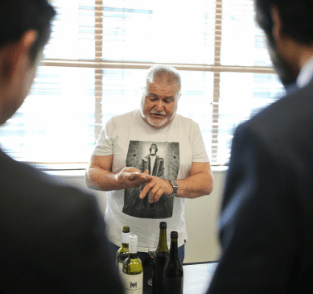
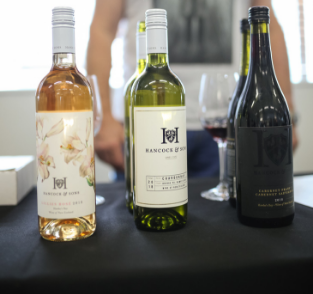
John Hancock explains his winemaking philosophy.
I moved on to have a chat with John Hancock, an old acquaintance of mine. I have followed John as a wine maker and colleague since I first discovered his Morton Estate Black Label Chardonnay back in 1994. At one time his name was synonymous with Chardonnay in New Zealand. With his time both in Australia and in France working for the fabled P. Jaboulet of La Chapelle Hermitage he was no one trick pony.
Moving to Trinity Hill in the mid 90’s, John showed this and then some. With the production of the Homage Syrah and Homage Chardonnay (when vintages permitted), John showed a wine to the world that truly was a pioneer in putting new Zealand Syrah on the world map . He also planted some of the first Viognier and Pinot Gris vines in New Zealand. Tempranillo and Montepulciano were also to follow. John was also one of the first to jump on the band wagon with the Gimblett Gravels. A pioneer not just in differing grapes, classical representations but regionalised recognition. A true believer in what could be achieved in New Zealand. Ironic considering his education and first jobs were all based in Aussie.
So walking up to John’s big grin, it was great to see him branching out on his own, under his own label Hancock and Sons. A contrast to some of his more prestigious history, Hancock and Son’s is mostly focused on accessible wines that reasonably priced. No multi tier here yet. John has always done this, but often his premier wines have taken the light away from some of his better value wines. I am was happy to say that the three wines on display certainly hit above their respective weight (price point). They weren’t entry mass produced wines and that was evident on tasting. They were crafted and handled carefully. In their own right these wines would become sought after.
To add to this John was sourcing his Cabernet France grapes for both the Rose and Cabernet Franc from the Howell Vineyard, made famous by Pyramid Valley’s use for almost 15 years. The Chardonnay sourced from a separate less renowned but no less qualitative focused grower in Bridge Pa also. John used fruit from Gimblett Gravels in his Cabernet Franc dominant red to add tannin depth and direct concentration.
All of his wines displayed excellent fruit, and most importantly balanced textural impacts.
Wine Notes: Hancock and Sons, 2018 Lillies Rose, Cab Franc from Howell Vineyard, Bridge Pa. Lovely pink blush centre with tinges of salmon. The nose shows mixed dried herb, sweet currants, tinges of strawberry, and a drying citrus undertone- I am leaning towards lime. The palate is wonderful and textured with currant, hints of herbal flintiness and slightly sweeter red berries. Medium bodied but with lower alcohol, the wine itself wasn’t too dry in the palate, and the phenolic balance was perfect with a hint of sweetness int he front of the mouth.
My favourite aspect was that through careful viticulture and wine making, volatile acidity was completely absent or so subtle I couldn’t detect, something that can show through particularly badly in rose. A lovely wine, and something a red wine drinker would enjoy.
Hancock and Sons, 2018 Chardonnay, Bridge Pa. A lovely pale straw gold, with some light green tinges. The nose showed classic Hawke’s Bay stonefruit, peach, unripe apricot, and ripe gala apple. Tinges of oaken spice and lees influences displayed as well, but were short, I am guessing due to age and bottling time. The palate texture displayed the oak and lees influence exceptionally well. Silken with citrus and peach mix, mineral hints and a clean finish, it was a lovely wine demonstrating what can be done. Burgundian clones dominated and this showed through with lean but not austere structure. Drinking really well now, but would blossom so well in time, particularly in its fruit profile which at the time of this tasting some what limited.
Hancock and Sons, 2018 Cabernet Franc %50 from Howell Vineyard, Bridge Pa, %30 Cabernet Franc from Gimblett Gravels and %20 Cabernet Sauvignon from Gimblett Gravels. This wine was a beautiful almost opaque deep garnet red with purple hints. The nose was closed and somewhat simple, but as John explained this was pretty much a barrel sample. Fresh blackberry (as opposed to the cassis characters) , cocoa and hints of chocolate and some slight leather tones all displayed. The palate was revealing as it was layered, but currently it was too young to truely assess. The acidity was balanced which in such a youthful wine was a good sign. Due to its concentration and the tannins displayed being so fine, I would suggest this is definitely a wine to watch out for.

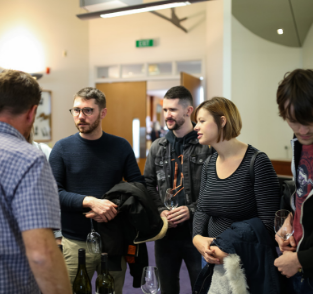
Stefan and Nadine Loetcher's Oak Estate from Hawkes Bay.


Nick Hewitt from Yalumba Wines.
In contrast to John’s own hands plunging the wines, the next table displayed the oldest family winery in Australasia - Yalumba.
The ever friendly Nick Hewitt (Certified Sommelier, Account Manager for Negociants New Zealand) was pouring and had a couple of real beauties. While there were numerous wines I love from Yalumba (Menzies, Virgilius, Signature, he also had a 98 Yalumba Reserve Cabernet Shiraz on hand....the list goes on and on) the wine that captured my imagination and has always held it is the 2015 Tricentary Grenache. So I focused on this wine. I remember when the first vintage of this was released back in the early 00’s under the “Hand Picked” series of Yalumba wines (I think it was 01 but could be wrong). It was only produced for one vintage before being reproduced in 2008.
The 820 odd Bush vines are over 130 years of age based in central Barossa.They use big hogshead barrels, to minimise the influence of oak. They only produce this wine in the years most deserving and while it isn’t as well known as Octavius, Menzies or the Signature, it is certainly worthy of accolade.
For those not familiar with Grenache, it can easily be modified by new oak and small barrels- resulting in wines that are often more dominated by oak influence than natural fruit. This means handling oak and the wine making process around this is very important. Skin contact is also important, and while Grenache handles heat well, light is more important as the photosynthetic influences bring out a larger range of fruit layers. Conversely however the grapes work best with good heat.
This combination can at best produce wines that are more complex and full bodied than their better known counter parts, and are often more approachable in their youth. Yalumba have dealt with this grape for a long time and are masters of it.
Wine Notes: 2015 Yalumba Barossa Tri - Centenary Grenache. Opaque dark garnet with ruddy edging. The nose shows classic ripe red berry- pomegranate and strawberry, soft spice, anise, and tinges of clay. As I swirled some of the classic meaty-ness Grenache can show came out along with chocolate, tinges of clay and lovely floral violets. The palate was layered and filled with complexity. The tannins were very evident but rather than drying they encompassed the mouth encouraging a longer swallow and salivation. Fruit tannin handled at its best. The textures and integration was superior to many Grenache I have had with the layers of flavours folding across the palate into a long finish. The flavour profile was very broad, and displayed ripe strawberry, black plum, chocolate and hints of dried aniseed. Just wow..
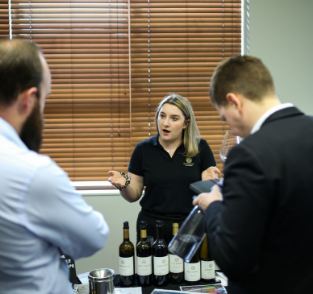
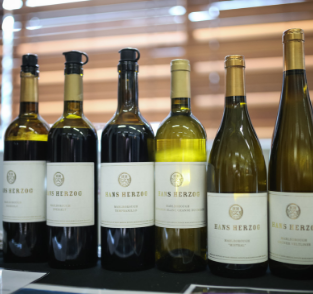
Maria Mencattelli from Hans Herzog.
-11.png?201908192138)
-10.png?201908192138)
Marguerite Dubois from Clos Marguerite.
After that wonderful wine I moved onto the lovely Marguerite from Clos Marguerite from Marlborough. She is certainly a personality and one of the most hard working people I have met in the industry. Between her husband and herself they have grown Clos Marguerite into a well recognised brand both here in New Zealand and internationally.
Producing 3 wines, a Pinot Noir, a Pinot Rose and a Sauvignon Blanc they have always worked hard to make the wines tell the story. They are released later, an expense which I agree has
ensured the wines are always best represented upon opening. The current vintages of 2018 for both the Pinot Noir and the Sauvignon Blanc were wonderful.
I am not a fan of Sauvignon Blanc personally -find the acidity a bit too much, I appreciate it, just struggle to enjoy more than a glass. Clos Marguerite’s however is a wine I can enjoy. Softer acidity with better layered textures and no sign of volatile acid.
It is their wonderfully savoury and spicy Pinot Noir that always attracts my attention. The wine displayed was the 2015 vintage- not currently available but an excellent wine to show off the quality and ageing potential.
Wine Notes: 2015 Clos Marguerite Marlborough Pinot Noir. Lovely semi transparent garnet scarlet centre to almost transparent red rim. The nose is lifted and highly aromatic with sour cherry, sandalwood, tinged red and white spice and some secondary development occuring. Palate is still very tight and slightly austere, and I think some decanting would open it up and loosen some of those acids. Again the tight currant, cherry influences dominated, and lovely drying tannins softened the elegant finish. A lovely wine that consistently produces Pinot Noir of the classic typicity that we often align with more old world Pinot Noirs. Thoroughly enjoyable.
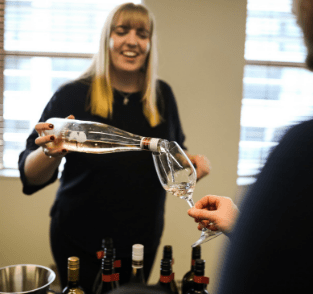

Jessica Bell, Brand Ambassador for Pernod Ricard and Church Road.
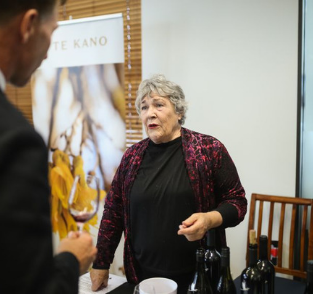
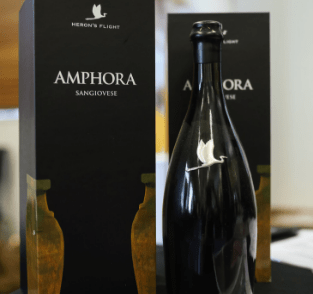
Mary Evans from Heron's Flight.
Moving onwards I got into a lovely discussion on Sangiovese with the lovely Mary Evans & David Hoskins from Heron’s Flight. A true pioneering couple, they planted originally in Chardonnay and then Sangiovese, in the region of Matakana back in 1987. Sangiovese was not a well known varietal, internationally let alone NZ. However with hard work, and support from some wine legends (the Babich family name came up several times) they evolved and now produce a range of Italian based varietals- all red.
My personal favourite is the classic Reserve Sangiovese. A tough and slow ripening varietal, requiring careful attention in the maritime influenced Matakana. The grapes can produce harmonious, textural and powerfully concentrated wines in great years, and be the exact opposite in more mediocre years in a climate like Matakana. The primary reason is the hard acidity the variety carries. Phenolic and acidic ripeness requires careful vineyard management as well as good wine making.
In the earlier years Mary and David had to learn by experience- a costly effort- as there were few experts in Italian varietals in New Zealand. As time passed however they began to master the grape. Careful pruning, trellising methods and wine making changes all enabled a more consistent product.
To capture this spirit, they packaged their Reserve Sangiovese in a beautiful exaggerated Bordeaux style bottle with a simple pewter heron adorning the label. The wine itself is lovely. The wine I tried on the day was the 2015 Reserve.
Wine Notes: 2015 Heron’s Flight Reserve Sangiovese, Matakana. The colour is opaque garnet to a ruddy edge. The nose is dominated by cherry, savoury leather, peppery characters, tinges of forest floor and plum. The palate is drying due to the high acidity, but is well balanced both with good phenolic structure and use of drying oak tannin. It creates a mouthfeel that cries out for food - like most Italian varietals- however it is an enjoyable drying influence. If I could decant I feel the complexity would be let free - at the moment its pretty tight wine. I noticed as I swirled characters of leather, sweet cedar wood, cranberry, ripe plum starting to show. An enticing wine that would benefit some time in the cellar.
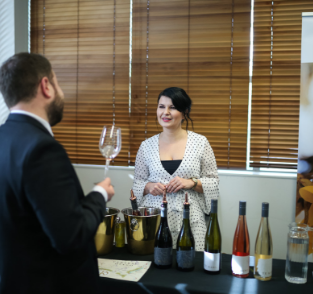
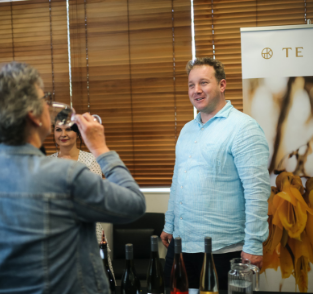
Monika & Chris from Te Kano Estate in Central Otago.
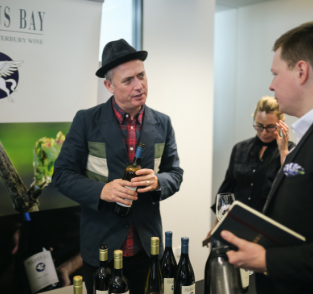
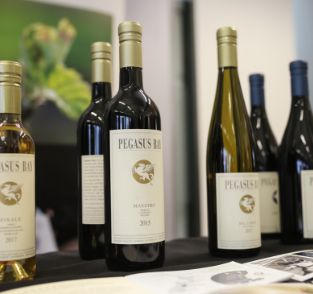
Edward Donaldson from Pegasus Bay.
At this point of the day I was struggling to get through all the available wines. I passed the wonderful Pegasus Bay wines- a vertical of Aria and Bel Canto Rieslings available, along with Pinot Noir, Chardonnay and Pinot Gris. I collect Aria and so was well familiar with 9 or so vintages available for tasting.
They are arguably the best Riesling producer in New Zealand, Framingham being the only other contender to the title. Both producers have a history of producing riesling exceeding 30 years.
Pegasus Bay’s story to that point was almost an accident with decisions to pull the Riesling vineyard being discussed from an early period in the Donaldson family. Thankfully through luck and fortune this decision was avoided.
Pegasus Bay consistently produces great wine. Most importantly they have an excellent understanding of their vineyards, and this gives them an insight and knowledge to the behaviour vintage to vintage. I can’t honestly think of one bad wine I have ever had from them. So although it was tempting I passed by to another icon of the NZ wine industry.
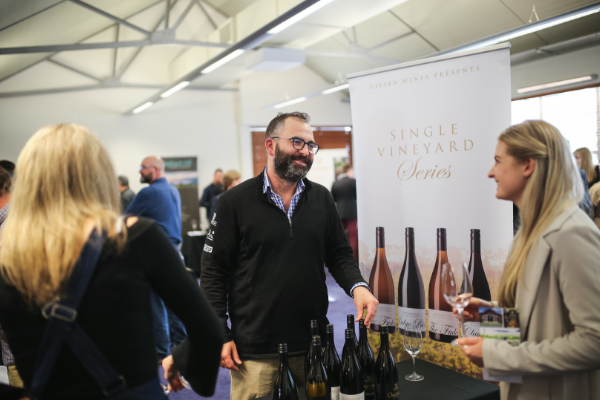
Giesen Group's Cameron McPhee holds the floor.
I had the pleasure of meeting Marcel Giesen in 2012. It was for another project he was working on, but I got to meet an icon whose influence in the industry has always been hidden to the general public. The family are iconic and while many people are familiar with Giesen Estate label, they may not be aware of their influence in single vineyard management, grape growing, and barrel importing.
Giesen wines has been around a long time, and much like Pegasus Bay, the family was based in Canterbury. While Pegasus Bay worked on developing a domestic and then international profile, Giesen focused on building the export market first, only recently devoting their attention to the local market. Also like Pegasus Bay, Giesen became known in the early days for quality riesling which they also still produce. Unlike Pegasus Bay though, the focus on export meant the team were engaged in broader thinking beyond just making wine. Further more their more prestigious labels rarely hit the local wine shop counter beyond the borders of the Canterbury and Marlborough sub regions.
This enabled them a cash flow that enabled investment in multi regional vineyard plantings. It wasn’t easy navigating, and their desire not to compromise meant at times sacrifices were made to ensure the brand was managed and represented correctly. However today they are vertically integrated, with a distributor structure, barrel importing, vine management consultancy and several vineyards of very high standing - including one of the most famous vineyards in Marlborough, if not New Zealand.
The Clayvin vineyard, was made famous by the team at Fromm Vineyards. The Chardonnay and Pinot Noir from this vineyard are stellar. Syrah was also produced here - and for a long time Fromm’s Syrah was considered (and still is in my opinion) amongst the best and most consistent Syrah in New Zealand. I would have to say in tasting that Giesen’s Clayvin Vineyard Syrah carries that title forward also. Giesen produce Pinot Noir and Syrah under the Clayvin label with the Chardonnay being denoted as Southern Valleys.
Giesen’s refocus on the local market, as well as the introduction of several new tiers of label, have meant they are now a force in premium wine production to be reckoned with. I have enjoyed all of the Giesen Wines I have tried recently. The two new premium labels of the Fuder series - a selection of single vineyard Sauvignon Blancs and Pinot Noirs from Marlboroughs premium sites, the Clayvin labels and the very recently Organic Label- a prestigious black labeled limited edition Pinot Noir and Syrah- have certainly attracted deserved attention.
As my palate was fatiguing I asked Key Account Manager Cameron McPhee what he would recommend if I was to taste one (as opposed to just having a drink!). He laughed and immediately poured the 2015 Organic Syrah from Marlborough. Let’s just say I was glad it was the last tasting - because it also became my drinker for the next hour or so.
Wine Notes: 2015 Giesen Marlborough Organic Syrah- limited release. Dark opaque inky purple with red garnet rim. The nose showed wonderful spiced plum, cocoa, earthy wooded notes and layers of violets and juniper. The nose really popped- fragrant and enchanting- a wine to engage in smelling as much as tasting. The palate was sensual, with firm tannins creating an envelope that encapsulated the opulent fruit. The plum and blackberry was immediately evident, but subtly restrained by smokey wood and some fungal notes. Lovely beguiling wine!
-6.png?201908192150)
All in all I would like to thank all producers whom were there. The wines on display were exciting, interesting and engaging. As a Sommelier the opportunity to understand the story behind these wines is as important as the wines themselves.
I would recommend if you are serious about developing your wine knowledge as a Service Professional or budding Sommelier- this is an outstanding opportunity to be involved not just with the competion but also with directly with the trade. As I stated earlier the opportunity to engage is easier due to the people being in attendance only being Sommeliers or Service Professionals. There is no fighting past 20 trainee bar tenders cause one of the wines is expensive. This is an excellent opportunity to spend time with wine makers and brand leaders that I can not stress enough.
Thank you and hope to see you all next year.
- Jeremy Ellis
